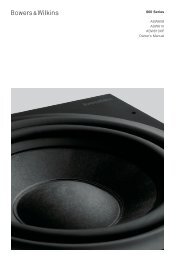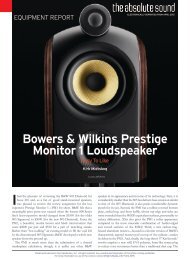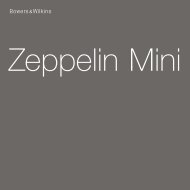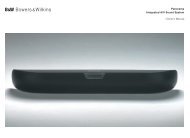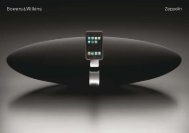CT8 XO Mk2 Manual - Bowers & Wilkins
CT8 XO Mk2 Manual - Bowers & Wilkins
CT8 XO Mk2 Manual - Bowers & Wilkins
You also want an ePaper? Increase the reach of your titles
YUMPU automatically turns print PDFs into web optimized ePapers that Google loves.
Although the speakers are semi-active and require an active crossover, all<br />
power amplification must be separately sourced. Each <strong>CT8</strong> LR, <strong>CT8</strong> CC<br />
and <strong>CT8</strong> DS requires two channels of power amplification, or three if used<br />
with a <strong>CT8</strong> SW subwoofer. This allows the user maximum flexibility in<br />
choosing these components.<br />
The <strong>CT8</strong> SW subwoofer, unlike the majority of subwoofers currently<br />
available, does not contain its own power amplifier and is used in a<br />
different manner than is usual. The original concept of home theatre<br />
based on various Dolby Digital and DTS systems advocates five or more<br />
main channels plus a single Low Frequency Effects (LFE) channel. The<br />
main channels contain full range signals and the LFE channel contains<br />
special effects up to approximately 140Hz. Recognising that many people<br />
do not want five or more full-range speakers in one room, Dolby Digital<br />
and DTS systems allow for the main channels to operate with small<br />
speakers having a restricted bass extension. The lowest frequencies from<br />
these channels are filtered off and added to the LFE channel to be<br />
reproduced by a subwoofer. The filter cut-off frequency is normally set at<br />
around 80Hz, the rationale being that sound gets progressively less<br />
directional the lower the frequency and localisation becomes less<br />
important. This is true to some extent, but the ears can process directional<br />
information at very low frequencies and the more the bass of the main<br />
channels is extended, the more realistic the sound stage becomes. Many<br />
high-end processors offer lower filter cut-off frequencies for this very<br />
reason.<br />
To preserve this directional information, a <strong>CT8</strong> SW may be added to each<br />
of the main channels as desired, extending the frequency response well<br />
below 20Hz. The minimum recommended configuration is to assign one<br />
subwoofer to each of the front left and right channels, restoring some<br />
directional information to the action directly on the screen and full<br />
directional information to 2-channel audio programme. The sense of<br />
spatial acoustic improves as more subwoofers are added to the remaining<br />
channels. If higher sound levels are required for larger listening<br />
environments and greater realism, up to two subwoofers may be added to<br />
each main channel. (It should be noted here that the addition of more<br />
subwoofers to any single channel requires an adjustment of the subwoofer<br />
output level of that channel’s <strong>CT8</strong> <strong>XO</strong> in order to restore the correct tonal<br />
balance.) The LFE channel is then distributed to all the main channels that<br />
have a subwoofer assigned by the simple action of configuring the<br />
surround processor as if there were no subwoofer present and specifying<br />
where the LFE signal should be routed. Strictly speaking, the phrase “no<br />
subwoofer” here means “no subwoofer dedicated to the LFE channel”.<br />
6<br />
Safety Warning!<br />
A <strong>CT8</strong>00 system is capable of producing very high sound<br />
pressure levels. Prolonged exposure to high sound levels<br />
can lead first to temporary and later permanent hearing<br />
damage. Do not exceed recommended Leq (equivalent<br />
sound level) exposure levels, for example, those specified<br />
in ISO 1999:1990.





